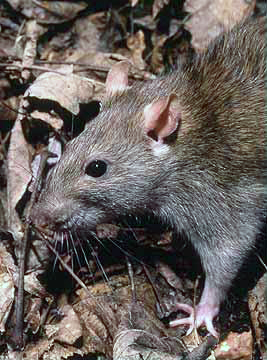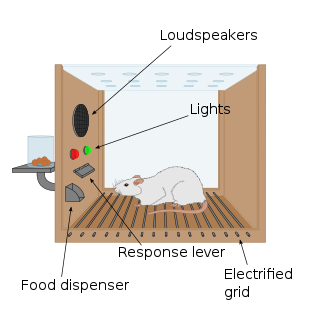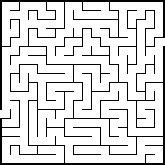
Rats are various medium-sized, long-tailed rodents. Species of rats are found throughout the order Rodentia, but stereotypical rats are found in the genus Rattus. Other rat genera include Neotoma, Bandicota and Dipodomys.

The brown rat, also known as the common rat, street rat, sewer rat, wharf rat, Hanover rat, Norway rat and Norwegian rat, is a widespread species of common rat. One of the largest muroids, it is a brown or grey rodent with a body length of up to 28 cm (11 in) long, and a tail slightly shorter than that. It weighs between 140 and 500 g. Thought to have originated in northern China and neighbouring areas, this rodent has now spread to all continents except Antarctica, and is the dominant rat in Europe and much of North America. With rare exceptions, the brown rat lives wherever humans live, particularly in urban areas.

An operant conditioning chamber is a laboratory apparatus used to study animal behavior. The operant conditioning chamber was created by B. F. Skinner while he was a graduate student at Harvard University. The chamber can be used to study both operant conditioning and classical conditioning.

Animal cognition encompasses the mental capacities of non-human animals including insect cognition. The study of animal conditioning and learning used in this field was developed from comparative psychology. It has also been strongly influenced by research in ethology, behavioral ecology, and evolutionary psychology; the alternative name cognitive ethology is sometimes used. Many behaviors associated with the term animal intelligence are also subsumed within animal cognition.
The term laterality refers to the preference most humans show for one side of their body over the other. Examples include left-handedness/right-handedness and left/right-footedness; it may also refer to the primary use of the left or right hemisphere in the brain. It may also apply to animals or plants. The majority of tests have been conducted on humans, specifically to determine the effects on language.

The radial arm maze was designed by Olton and Samuelson in 1976 to measure spatial learning and memory in rats. The original apparatus consists of eight equidistantly spaced arms, each about 4 feet long, and all radiating from a small circular central platform. At the end of each arm there is a food site, the contents of which are not visible from the central platform.
Metacognition is an awareness of one's thought processes and an understanding of the patterns behind them. The term comes from the root word meta, meaning "beyond", or "on top of". Metacognition can take many forms, such as reflecting on one's ways of thinking, and knowing when and how oneself and others use particular strategies for problem-solving. There are generally two components of metacognition: (1) cognitive conceptions and (2) cognitive regulation system. Research has shown that both components of metacognition play key roles in metaconceptual knowledge and learning. Metamemory, defined as knowing about memory and mnemonic strategies, is an important aspect of metacognition.

Latent learning is the subconscious retention of information without reinforcement or motivation. In latent learning, one changes behavior only when there is sufficient motivation later than when they subconsciously retained the information.

Emotion is defined as any mental experience with high intensity and high hedonic content. The existence and nature of emotions in non-human animals are believed to be correlated with those of humans and to have evolved from the same mechanisms. Charles Darwin was one of the first scientists to write about the subject, and his observational approach has since developed into a more robust, hypothesis-driven, scientific approach. Cognitive bias tests and learned helplessness models have shown feelings of optimism and pessimism in a wide range of species, including rats, dogs, cats, rhesus macaques, sheep, chicks, starlings, pigs, and honeybees. Jaak Panksepp played a large role in the study of animal emotion, basing his research on the neurological aspect. Mentioning seven core emotional feelings reflected through a variety of neuro-dynamic limbic emotional action systems, including seeking, fear, rage, lust, care, panic and play. Through brain stimulation and pharmacological challenges, such emotional responses can be effectively monitored.

The reward system is a group of neural structures responsible for incentive salience, associative learning, and positively-valenced emotions, particularly ones involving pleasure as a core component. Reward is the attractive and motivational property of a stimulus that induces appetitive behavior, also known as approach behavior, and consummatory behavior. A rewarding stimulus has been described as "any stimulus, object, event, activity, or situation that has the potential to make us approach and consume it is by definition a reward". In operant conditioning, rewarding stimuli function as positive reinforcers; however, the converse statement also holds true: positive reinforcers are rewarding.The reward system motivates animals to approach stimuli or engage in behaviour that increases fitness. Survival for most animal species depends upon maximizing contact with beneficial stimuli and minimizing contact with harmful stimuli. Reward cognition serves to increase the likelihood of survival and reproduction by causing associative learning, eliciting approach and consummatory behavior, and triggering positively-valenced emotions. Thus, reward is a mechanism that evolved to help increase the adaptive fitness of animals. In drug addiction, certain substances over-activate the reward circuit, leading to compulsive substance-seeking behavior resulting from synaptic plasticity in the circuit.
Comparative cognition is the comparative study of the mechanisms and origins of cognition in various species, and is sometimes seen as more general than, or similar to, comparative psychology. From a biological point of view, work is being done on the brains of fruit flies that should yield techniques precise enough to allow an understanding of the workings of the human brain on a scale appreciative of individual groups of neurons rather than the more regional scale previously used. Similarly, gene activity in the human brain is better understood through examination of the brains of mice by the Seattle-based Allen Institute for Brain Science, yielding the freely available Allen Brain Atlas. This type of study is related to comparative cognition, but better classified as one of comparative genomics. Increasing emphasis in psychology and ethology on the biological aspects of perception and behavior is bridging the gap between genomics and behavioral analysis.
Animal psychopathology is the study of mental or behavioral disorders in non-human animals.

Conditioned place preference (CPP) is a form of Pavlovian conditioning used to measure the motivational effects of objects or experiences. This motivation comes from the pleasurable aspect of the experience, so that the brain can be reminded of the context that surrounded the "encounter". By measuring the amount of time an animal spends in an area that has been associated with a stimulus, researchers can infer the animal's liking for the stimulus. This paradigm can also be used to measure conditioned place aversion with an identical procedure involving aversive stimuli instead. Both procedures usually involve mice or rats as subjects. This procedure can be used to measure extinction and reinstatement of the conditioned stimulus. Certain drugs are used in this paradigm to measure their reinforcing properties. Two different methods are used to choose the compartments to be conditioned, and these are biased vs. unbiased. The biased method allows the animal to explore the apparatus, and the compartment they least prefer is the one that the drug is administered in and the one they most prefer is the one where the vehicle is injected. This method allows the animal to choose the compartment they get the drug and vehicle. In comparison, the unbiased method does not allow the animal to choose what compartment they get the drug and vehicle in. Instead, the researcher chooses the compartments.
Self-administration is, in its medical sense, the process of a subject administering a pharmacological substance to themself. A clinical example of this is the subcutaneous "self-injection" of insulin by a diabetic patient.
The Five-choice serial-reaction time task (5CSRTT) is a laboratory behavioral task used in psychological research to assess visuospatial attention and motor impulsivity in animals. The task takes place within an operant chamber equipped with at least five holes (apertures) that can illuminate, and a food tray to deliver reward. The 5CSRTT requires the animal to correctly identify which of the five apertures has been briefly illuminated, via a nose poke, in order to receive a sugar reward. The difficulty of the task is controlled by the length of time the aperture is illuminated: a shorter illumination time requires the animal to pay greater attention, and thus is more difficult. Between every trial, there is also a short interval wherein the animal must withhold all responses, and any responding during this interval is met with a brief time-out and recorded as a failure of inhibitory control.
Episodic-like memory is the memory system in animals that is comparable to human episodic memory. The term was first described by Clayton & Dickinson referring to an animal's ability to encode and retrieve information about 'what' occurred during an episode, 'where' the episode took place, and 'when' the episode happened. This ability in animals is considered 'episodic-like' because there is currently no way of knowing whether or not this form of remembering is accompanied by conscious recollection—a key component of Endel Tulving's original definition of episodic memory.

In behavioral science, a T-maze is a simple forked passage used in animal cognition experiments. It is shaped like the letter T, providing the subject, typically a rodent, with a straightforward choice. T-mazes are used to study how the rodents function with memory and spatial learning through applying various stimuli. Starting in the early 20th century, rodents were used in experiments such as the T-maze. These concepts of T-mazes are used to assess rodent behavior. The different tasks, such as left-right discrimination and forced alternation, are mainly used with rodents to test reference and working memory.

Most mammals are viviparous, giving birth to live young. However, the five species of monotreme, the platypuses and the echidnas, lay eggs. The monotremes have a sex determination system different from that of most other mammals. In particular, the sex chromosomes of a platypus are more like those of a chicken than those of a therian mammal.

In zoology, copulation is animal sexual behavior in which a male introduces sperm into the female's body, especially directly into her reproductive tract. This is an aspect of mating. Many aquatic animals use external fertilization, whereas internal fertilization may have developed from a need to maintain gametes in a liquid medium in the Late Ordovician epoch. Internal fertilization with many vertebrates occurs via cloacal copulation, known as cloacal kiss, while most mammals copulate vaginally, and many basal vertebrates reproduce sexually with external fertilization.
Inequity aversion in animals is the willingness to sacrifice material pay-offs for the sake of greater equality, something humans tend to do from early age. It manifests itself through negative responses when rewards are not distributed equally between animals. In controlled experiments it has been observed, to varying degrees, in capuchin monkeys, chimpanzees, macaques, marmosets, dogs, wolves, rats, crows and ravens. No evidence of the effect was found in tests with orangutans, owl monkeys, squirrel monkeys, tamarins, kea, and cleaner fish. Based on mixed results in experimental studies it may be concluded that some bonobos, baboons, gibbons, and gorillas are inequity averse. Disadvantageous inequity aversion, which occurs when the animal protests as it gets a lesser reward than another animal, is most common. But advantageous inequity aversion has been observed as well, in chimpanzees, baboons and capuchins: the animal protests when it gets a better reward. Scientists believe that sensitivity to inequity co-evolved with the ability to cooperate, as it helps to sustain benefitting from cooperation. There is little evidence for inequity aversion in non-cooperative species.











